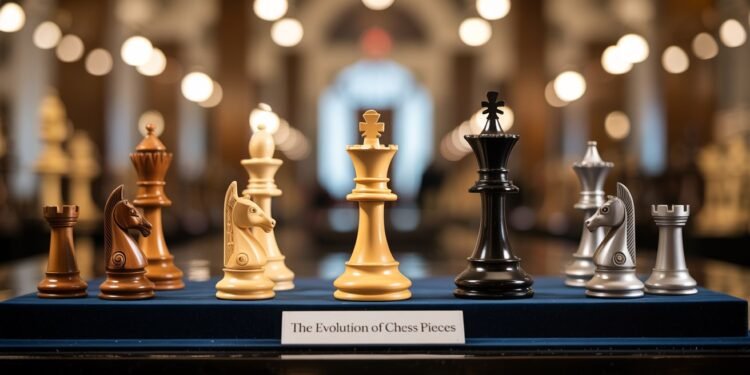Last Updated on November 20, 2025 by admin
Chess is more than just a game; it’s a window into the creative and cultural expressions of the societies that embraced it throughout history. From its origins on ancient battlefields to its current standing as a modern intellectual pursuit, the design of chess pieces reveals as much about artistry and heritage as it does about strategy and intellect. In fact, enthusiasts around the world continue to seek out historical chess sets for their aesthetic appeal, craftsmanship, and connections to significant periods in human culture.
The journey of chess pieces—through ancient dynasties, medieval courts, the Industrial Age, and into 21st-century innovation—mirrors broader social evolutions. These intricately carved figures, once shaped by the beliefs and values of their era, now captivate both collectors and casual players for their beauty and the stories they tell.
Understanding the evolution of chess pieces enhances one’s appreciation for the game itself, revealing a cross-section of military history, religious perspectives, and artistic achievements. The rise of unique chess sets over time has fostered a vibrant global community passionate about collecting and preserving the heritage of chess.
For many, exploring the evolution of chess design not only offers artistic inspiration but also a deeper connection to the past. Tangible links to history, such as the famous Lewis chessmen and the renowned Staunton set, serve as reminders of how chess has traversed boundaries and eras.
Origins of Chess Pieces
The story of modern chess begins in the Indian subcontinent with chaturanga, a game that represents the four arms of an ancient army: infantry, cavalry, elephants, and chariots. Each figure was assigned a tactical role that echoed battlefield responsibilities. As chess spread to Persia and subsequently to the broader Islamic world, the representation of these pieces transformed. Islamic artisans, averse to lifelike depictions due to their religious beliefs, sculpted abstract pieces that focused on functionality while hinting at original forms. This era marked the beginning of chess pieces as both objects of strategy and art, setting the stage for future cultural adaptation.
Medieval European Influences
Chess arrived in Europe through the Moorish conquest of Spain and via trade routes, where it quickly flourished. Unlike their abstract predecessors, European chess pieces evolved into pronounced figures, reflecting the social and political realities of the Middle Ages. Kings, queens, knights, and bishops—the power players of medieval feudalism—were immortalized on the chessboard. Highly decorative sets, such as the 12th-century Lewis chessmen unearthed in Scotland, exemplified this new emphasis on realism and storytelling, each piece brimming with character and detail. The emergence of these tangible forms made chess more accessible and engaging across the continent. Learn more about the Lewis chessmen.
The Staunton Standardization
By the 19th century, chess had gained international traction, but the diversity of chess set designs created confusion in competitions and hindered universal play. The Staunton set, introduced in 1849 by Nathaniel Cook and endorsed by chess master Howard Staunton, addressed these challenges with clarity and uniformity. The pieces—practical, weighted for balance, and highly recognizable—became the gold standard. Today, official tournaments worldwide rely on Staunton sets, which symbolize chess’s commitment to fairness and accessibility. The impact of this design resonates not only in competition but also in mass-produced home sets and luxury collectibles.
Cultural Symbolism in Chess Pieces
Beneath the surface, each chess piece is imbued with symbolism shaped by the values and structure of the societies from which they emerged. The king, whose capture determines defeat, represents ultimate authority, while the queen’s expanded power on the board reflects shifting views on female leadership throughout history. Bishops signify the church’s influence, and knights embody the spirit of chivalry. The humble pawn, though easily sacrificed, holds the promise of transformation—a powerful metaphor for social mobility and change. These motifs continue to inspire artists, crafters, and enthusiasts who study how the game mirrors the world beyond the board.
Artistic Expression Through Chess Sets
Beyond gameplay, chess pieces have served as miniature sculptures, allowing artists and artisans to express cultural identity and creativity. Traditional sets feature materials like ivory, jade, and rare woods, with piece designs ranging from mythical creatures to national heroes. Archaeological finds such as the Clonard chess piece—an intricate 12th-century ivory bishop from Ireland—testify to the enduring intersection between chess and the decorative arts. Museums display countless historic pieces, each with a distinct narrative and artistic flair.
Modern Innovations in Chess Design
The modern era has seen unprecedented creativity in the world of chess design. Materials such as acrylic, glass, resin, and even 3D-printed composites give contemporary pieces an avant-garde edge. Minimalist aesthetics, inspired by modernist art, appeal to new generations and offer fresh interpretations of classic forms. Collaborations with celebrated designers and architects yield limited edition sets that become instant collector’s items. These exciting innovations honor chess’s history while celebrating the freedom of artistic reinvention in the digital age.
Collecting Historic Chess Sets
The world of chess set collecting is both captivating and highly specialized. For aficionados, antique sets are treasures that embody centuries of culture, craftsmanship, and play. Sets like the Dubrovnik, favored by Bobby Fischer, and other rare designs are valued for their quality, provenance, and the stories they hold. Collectors learn to evaluate sets by era, material, condition, and authenticity, making each acquisition part of an ever-unfolding historical narrative. For an overview of various iconic chess sets, see this feature by The New York Times.
Conclusion
The evolution of chess pieces is a microcosm of human creativity, resilience, and progression. From ancient empires to present-day studios, every piece—whether fashioned from bone, wood, metal, or glass—tells a story. Chess continues to bridge cultures, sparking ingenuity and inviting reflection on the passage of time, inviting all who play to appreciate not just the game but the multifaceted heritage it represents.
Do Read: Creative Learning Through the Reggio Emilia Approach: Unlocking Children’s Potential









